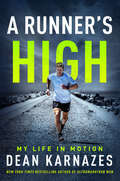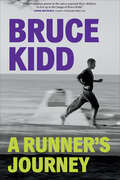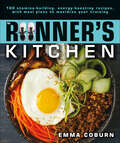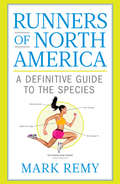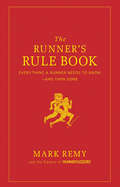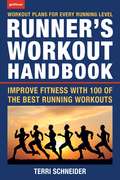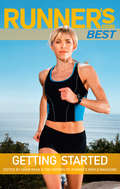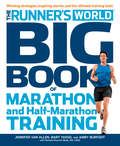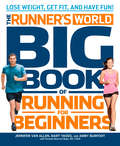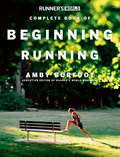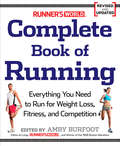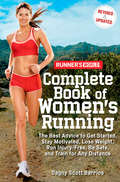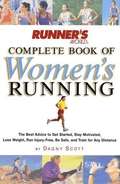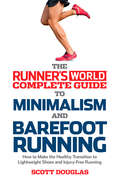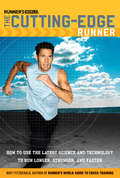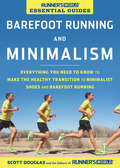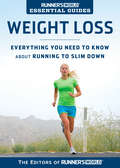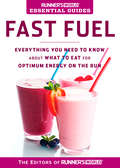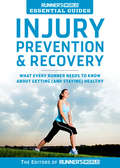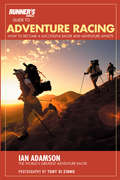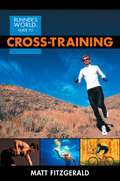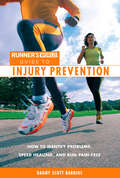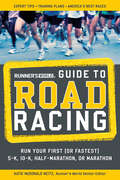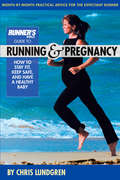- Table View
- List View
A Runner's High: My Life in Motion
by Dean KarnazesNew York Times bestselling author and ultramarathoning legend Dean Karnazes has pushed his body and mind to inconceivable limits, from running in the shoe melting heat of Death Valley to the lung freezing cold of the South Pole. He’s raced and competed across the globe and once ran 50 marathons, in 50 states, in 50 consecutive days. In A Runner’s High, Karnazes chronicles his extraordinary adventures leading up to his return to the Western States 100-Mile Endurance Run in his mid-fifties after first completing the race decades ago. The Western States, infamous for its rugged terrain and extreme temperatures, becomes the most demanding competition of Karnazes’s life, a physical and emotional reckoning and a battle to stay true to one’s purpose. Confronting his age, his career path, and his life choices, we see Karnazes as we never have before. For Karnazes, the running experience is about the runner and the trail. It is not the sum of achievements but a story that continues to be told each day, with each step. A Runner’s High is at once an endorphin-fueled adventure and a love letter to the sport from one of its most celebrated ambassadors that will leave both casual and serious runners cheering.
A Runner’s Journey
by Bruce KiddIn the 1960s, Bruce Kidd was one of Canada’s most celebrated athletes. As a teenager, Kidd won races all over the globe, participated in the Olympics, and started a revolution in distance running and a revival in Canadian track and field. He quickly became a symbol of Canadian youth and the subject of endless media coverage. Although most athletes of his generation were cautioned to keep their opinions to themselves, Kidd took it upon himself to speak out on the problems and possibilities of Canadian sport. Encouraged by his parents and teammates, Kidd criticized the racism and sexism of amateur sport in Canada, the treatment of players in the National Hockey League, American control of the Canadian Football League, and the uneven coverage of sports by the media – and he continues to fight for equity to this day. After retiring from his career as an athlete, Kidd became a well-known advocate for gender and racial justice and an academic leader at the University of Toronto. Depicting a Canadian sport legend’s journey of joy, discovery, and activism, this memoir bears witness to the remarkable changes Bruce Kidd has lived through in more than seventy years of participation in Canadian and international sports.
The Runner's Kitchen: 100 Stamina-Building, Energy-Boosting Recipes, with Meal Plans to Maximize Your
by Emma CoburnWhether you're training for your first 6-mile run or preparing for your latest marathon, this sports nutrition guide will help you achieve your running goals!Get ready to power your runs with delicious recipes brought to you by Olympian Emma Coburn. Packed with nutritious, wholesome meals that will sustain you through the toughest workouts, The Runner&’s Kitchen is the ultimate cookbook for runners!With power to every page, dive right in to discover:- 100 satisfying recipes from Emma's kitchen complete with handy nutritional information- 7-day meal plans for peak training, race week, and recovery- Insights into Emma's personal nutrition philosophy and training scheduleThis cookbook is packed with mouthwatering recipes for runners incorporating breakfast, lunch, and dinner, plus snacks and sweet treats, featuring the necessary nutritional information to keep you right on track. From everything bagels and naan flatbread to protein-packed chocolate mousse and cinnamon cookies, this flavor-forward cookbook proves that food can be delicious and nourishing at the same time.The Runner's Kitchen shows you that fueling for performance doesn't have to mean flavorless foods.Instead, it&’s all about finding a balance that allows you to provide your body with the fuel it needs to perform and recover while still enjoying the foods you love.Serious running requires serious fuel!In fact, how you fuel is just as important as how you train to reach your full potential as an athlete. From getting the right nutrients to help boost your performance to recovery-friendly recipes, this runner&’s recipe book will equip you with all the information you need to get the most from your training. It's the perfect fitness gift for runners and athletes alike.Fancy getting fitter this New Year? This must-have volume is equipped with tons of tips and tricks to get you on the right track with your running, and help you stay there!On your mark, get set, go!
Runners of North America: A Definitive Guide to the Species (Runner's World)
by Mark RemyIf there's one thing that Mark Remy knows, it's running. After 25 marathons and a career of writing for and about runners in Runner's World, he is well equipped to dissect the running world and the odd creatures that make up its population.The North American Runner has evolved greatly over the years, adapting to changes in environment, including new threats, technologies, food sources, and fashion. These mysterious, brightly clad creatures live side by side with humans, but how many of us truly understand them?In Runners of North America, a comprehensive guide to the 23 subspecies of runners (ranging from The Newbie to The Gear Addict), humor writer Mark Remy presents the tools to observe and communicate with runners in their natural habitat. With chapters like "Diet and Nutrition" and "Mating Habits," Runners of North America examines and explains the lives of runners from every conceivable angle--while delivering plenty of laughs along the way.
The Runner's Rule Book: Everything a Runner Needs to Know--And Then Some (Runner's World)
by Mark Remy Editors of Runner's WorldEvery sport has rules. Running is no exception. If you're curious, just visit the Web site of USA Track & Field, the sport's governing body, where you'll find detailed dictates on everything from disqualification to bib-number placement to the caliber of the starter's pistol.But what about the everyday rules of running? The unspoken ones that pertain to the lingo, behavior, and etiquette that every seasoned runner seems to know and every newbie needs to learn? Veteran runner Mark Remy and the editors of Runner's World magazine provide answers to these very questions and many more in The Runner's Rule Book.With 100+ rules that cover the basics of running, racing, track etiquette, and apparel and gear, including hilarious running commentary on running culture, The Runner's Rule Book will be the reference guide you'll turn to again and again for answers to your burning running questions.
The Runner's Workout Handbook: Improve Fitness with 100 of the Best Running Workouts
by Terri SchneiderWhether you run competitively, to get fit or to stay fit, The Runner’s Workout Handbook is your complete guide to finding innovative and engaging running plans to make the most of your training time, providing a wide variety of workouts to keep you challenged and motivated, all while improving your performance.Expert and multi-sport coach Terri Schneider combines skill training with variations in speed, distance, and technique for an effective and easy-to-follow series of running workouts designed to make you a stronger, faster, and more proficient runner.The Runner’s Workout Handbook includes:• 100 running workouts for all experience levels• Expert-designed track and field workouts• A guide to common terms used in the workouts• Information on gear and guidelines to get the most out of your workoutsRunning is the easiest and most affordable way to build and maintain your fitness, and can be tailored to work your core, muscular strength, and cardiovascular endurance. The Runner’s Workout Handbook will keep you challenged and motivated like never before!Go online to www.getfitnow.com for support, additional workouts, and more!
Runner's World Best: Getting Started (Runner's World)
by Adam Bean Editors of Runner's WorldGetting Started provides beginning runners with everything they need to know to get off on the right foot. Full-color photographs demonstrate proper running technique and equipment. Runners learn how to incorporate interval, tempo, and Fartlek training to achieve optimum performance from the start. Rounding out the volume are cross-training suggestions, along with valuable tips on increasing speed and endurance.
The Runner's World Big Book of Marathon and Half-Marathon Training: Winning Strategies, Inpiring Stories, and the Ultimate Training Tools (Runner's World)
by Jennifer Van Allen Bart Yasso Amby BurfootThe first dedicated book on marathon and half marathon training from the renowned experts at Runner's World Runner's World Big Book of Marathon and Half-Marathon Training gives readers the core essentials of marathon training, nutrition, injury prevention, and more. The editors of Runner's World know marathon training better than anyone on the planet. They have spent the last few years inviting readers to share the long, sweaty journey to the starting line, putting themselves on call to personally answer readers' questions 24/7. This book includes testimonials from real runners, more than 25 training plans for every level and ability, workouts, a runner's dictionary, and sample meal plans. Runner's World Big Book of Marathon and Half-Marathon Training is a powerful and winning resource—the ultimate tool kit for anyone who wants to get from the starting line to the finish line.
The Runner's World Big Book of Running for Beginners: Lose Weight, Get Fit, and Have Fun (Runner's World)
by Jennifer Van Allen Bart Yasso Amby Burfoot Pam Nisevich BedeEvery day, people are reaching their get-up-or-give-up moments and resolving to change. And they're realizing that running is the simplest, cheapest, and most effective way to lose weight, gain confidence, and relieve stress. For newcomers, the obstacles are fierce. There are fears of pain and embarrassment. There are schedules jam-packed with stressful jobs, long commutes, endless meetings, and sticky-fingered toddlers.The Runner's World Big Book of Running for Beginners provides all the information neophytes need to take their first steps, as well as inspiration for staying motivated. The book presents readers with tips for smart nutrition and injury prevention that enable beginning runners to achieve gradual progress (by gearing up for a 30-minute run, a 5-K, or even a 5-miler). Above all, it shows newbies just how fun and rewarding the sport can be, thanks to the help of several "real runner" testimonials.
Runner's World Complete Book of Beginning Running (Runner's World)
by Amby BurfootRunner's World Complete Book of Beginning Running by Amby Burfoot is the newest addition to the heralded Runner's World series focuses exclusively on the concerns of the tens of thousands of new runners who take up the sport every year.Recognizing that newcomers to a sport need all the help they can get, Runner's World now devotes an entire book to guiding the beginning runner through those challenging first days, weeks, and months. Peppered throughout with motivating tips and advice from those who have been there, this much-needed volume presents a can't-fail program that is sure to help new runners feel and look better and have more energy and less stress. Inside you'll find: • Information on nutrition and how to adjust your diet to fit your new running lifestyle • Training advice, including how to use cross-training, stretching, and strength exercises to keep enthusiasm up, weight down, and fitness at an optimum level • A special section for women runnersWritten by the executive editor of Runner's World magazine and covering every problem the new runner may encounter-from choosing the right shoes to preventing injury to preparing for a race-this authoritative volume provides all the information and inspiration any novice requires to turn running into a healthy, lifetime pursuit.
Runner's World Complete Book of Running: Everything You Need to Run for Weight Loss, Fitness, and Competition (Runner's World)
by Amby BurfootThe sport of running is ever changing, be it the shoes we wear or the goals we set, the training methods we use or the role models we emulate. But there is one constant: For 40 years, Runner's World magazine has been recognized worldwide as the leading authority on running. Now the collective wisdom of the most savvy running writers, coaches, and editors can be found in the Runner's World Complete Book of Running. Whether you are a beginner or veteran runner, here is advice--both timeless and cutting-edge--guaranteed to maximize your performance and enjoyment. Inside you'll find in-depth coverage of training and racing including: • A surefire plan to get beginners hooked on running • 15 surprising foods to boost your running performance • A proven plan to increase speed by training less • Tips from triathletes to maximize your training efficiency • A woman's encyclopedia of running • The big five running injuries and how to prevent them • An innovative running plan for weight-loss • Cross-training exercises that strengthen your core • How to train for your first half-marathon • Mental training tips for running a smart marathon Packed with valuable advice from running's top experts on everything from building strength, speed, and endurance to nutrition and injury prevention, the Runner's World Complete Book of Running is the book you'll turn to again and again to answer all of your running questions.
Runner's World Complete Book of Women's Running: The Best Advice to Get Started, Stay Motivated, Lose Weight, Run Injury-Free, Be Safe, and Train for Any Distance (Runner's World)
by Dagny Scott BarriosRunner's World Complete Book of Women's Running is designed specifically to address the unique challenges and rewards the sport presents to the fastest growing segment of the market—women runners. More than 10 million women across the country now identify themselves as regular runners. In response to the dramatic increase in the number of women in the sport, Dagny Scott Barrios and the experts at Runner's World have created this singular guide, where women will discover how to: • train for any race, from a 5K to a marathon • eat nutritiously and for maximum energy • lose weight permanently • deal with self-consciousness and body image • run during pregnancy and through menopause • choose the best clothes and accessories • run anywhere safely • prevent and treat injuries, especially those that women are most likely to encounter With clear photographs, running sidebars, and testimonials from women runners of all ages and abilities, this comprehensive resource provides the most current practical advice available anywhere for women runners of all levels.
Runner's World Complete Book of Women's Running: The Best Advice to Get Started, Stay Motivated, Lose Weight, Run Injury-Free, Be Safe, and Train for Any Distance
by Dagny ScottHere, in one neat package, is pretty much everything you need to know about trail running--running, that is, on dirt trails, not pavement. It isn't (or, at least, it doesn't have to be) torture, endless hours of negotiating tricky mountain paths and inclement weather. Trail running is, we're told, less hazardous, less painful, and less exhausting than pavement-pounding. It's all about relaxation and communing with nature. The book is full of tips, some of them presented in a helpful, question-and-answer format; there's an excellent chapter on outfitting yourself for trail running; another on how best to train before a run; another on preparing, if you're so inclined, for a marathon. The author, a longtime trail runner, approaches the subject from a commonsensical, practical angle, avoiding pseudophilosophical claptrap about the deep meaning of running. Instead, he offers a hands-on, nuts-and-bolts, filled-to-the-brim users' manual that targets both veteran and beginning trail runners.
Runner's World Complete Guide to Minimalism and Barefoot Running: How to Make the Healthy Transition to Lightweight Shoes and Injury-Free Running (Runner's World)
by Scott DouglasLearn Why Millions of Runners Have Decided That Less Is More!No topic in running has gotten more attention lately than minimalist shoes and barefoot running. Proponents say that running barefoot or in lighter, lower shoes leads to better running form and fewer injuries. But others caution that ditching your regular running shoes for barely there models can increase, not decrease, your risk of injury. In this indispensable guide, veteran running writer Scott Douglas draws on the knowledge of leading coaches and other running experts to show how and why to make the move safely to running in less shoe. Full of real-world wisdom, The Runner's World Complete Guide to Minimalism and Barefoot Running explains why most runners should consider minimalism, gives simple tests to determine if you're ready, shows how to make the transition safely to running in less shoe, and reveals easy exercises to improve your running form once you've switched. If you've been wondering whether minimalism and barefoot running are for you, let this book be your guide to a lifetime of healthy, happy running.
The Runner's World Cookbook: 150 Ultimate Recipes for Fueling Up and Slimming Down--While Enjoying Every Bite (Runner's World)
by Joanna Sayago Golub Editors of Runner's WorldRunners need to eat well in order to perform, and what they eat can have a direct influence on how they run. The Runner's World Cookbook is the perfect combination of performance-boosting nutrients to maximize performance with easy, delicious, and quick recipes. This cookbook contains 150 recipes sourced primarily from the authoritative voice in running itself, Runner's World magazine, along with exciting additional content. These recipes are intended to maximize a runner's performance and enhance nutritional benefits.The book will include two recipe indexes with visual keys for classification at the start of each recipe, with V (for vegetarian), VE (for vegan), GF (for gluten free), and more. The first section of the book focuses on nutritional information and staple ingredients every runner should know, and the second part of the cookbook illustrates how to turn these facts into delicious, quick, and nutrient-boosting meals through delectable recipes.Every recipe will have an easy-to-follow icon system to identify key recipe attributes (i.e., recoveryfriendly; low-calorie; quick and easy), along with a nutrition guide that will offer readers tips on how to make the healthiest choices regarding that particular category of food. Divided by categories (Salads/ Soups/Stews, Sandwiches/Wraps/Burgers, Pizza/Pasta, etc.), these recipes are presented by types of dishes runner can look to for satisfying performance needs in appetizing ways.
Runner's World The Cutting-Edge Runner: How to Use the Latest Science and Technology to Run Longer, Stronger, and Faster (Runner's World)
by Matt FitzgeraldA state-of-the-science resource for runners--with the latest information on training, nutrition, injury prevention, and gear and gadgets that improve performance.The science and technology of running have evolved dramatically in the past 20 years. This all-inclusive resource--based on the author's own high-level running and coaching experience and his interviews with dozens of other top runners and coaches--is an indispensable tool for runners who hope to perform at the very best of their ability.Runner's World The Cutting-Edge Runner provides: • A comprehensive overview of how the best competitive runners train today--covering such topics as periodization, physiological testing, group training, technique work, cross-training, recovery techniques, and individual customization • In-depth discussions of equipment and other technologies that can benefit the runner, including shoes, orthotics, heart rate monitors, altitude tents, training software, and more • A complete "menu" of workouts for milers to marathoners Whether he is explaining how to use hypoxic conditioning to increase oxygen consumption capacity, telling how to prepare for the mental challenge of racing, or detailing what the latest science has to say about the pros, cons, and proper usage of more than 15 nutritional supplements and drugs, Matt Fitzgerald goes straight to the most authoritative sources and provides practical ways for the average runner to adapt methods and tools used by top runners to their own running programs.
Runner's World Essential Guides: Everything You Need to Know to Make the Healthy Transition to Minimalist Shoes and Barefoot Running (Runner's World)
by Scott Douglas Editors of Runner's WorldThe basic rationale for running barefoot or in minimalist models goes something like this: Humans evolved to cover long distances by foot. By introducing a thick layer of cushioning and an elevated heel between the foot and the ground, modern running shoes alter natural running form. But modern running shoes alter form in ways that lead to injury. Therefore, getting back to a more natural running gait by running in little-to-no shoe will lead to improved form, which should lower injury rates.A key reason to run barefoot or in minimalist shoes is to allow your feet to work more naturally, free from the confines and controls of overly engineered running shoes. Unfortunately, too many runners, eager to run more naturally, have gone too far, too fast, from one extreme to the other. The realities of modern life have weakened our feet, ankles, and lower legs, and our bodies have adapted to the shoes we have worn for most of our lives; if we suddenly start running in little-to-no shoe, our bodies are not prepared for the new stresses.Runner's World Essential Guides: Barefoot Running and Minimalism provides historical context, thoughts, advice, and tips on making a healthy transition. The foremost authorities on running on the planet show you how to ease into a transition from conventional running shoes to barefoot running or minimalist shoes, starting with some simple at-home tests to see if your feet already have the strength they need to handle little-to-no shoe. You'll learn a step-by-step process for safely moving away from doing all your running in big, bulky shoes, including guidelines on how to introduce barefoot running into your regimen.Whether you want to learn more about the barefoot craze that's swept the nation or you want to introduce barefoot running into your training plan, this indispensable guide contains everything you need to get started!
Runner's World Essential Guides: Everything You Need to Know about Running to Slim Down (Runner's World)
by Editors of Runner's WorldThe miles you log are great for keeping you fit, healthy, and happy, and they help you to maintain your weight. But weight loss is a different story. Because you run, you may think you can eat whatever you want and still drop pounds. Unfortunately, that's not true. Running is only half the equation. You have to look hard at what and how you eat, too. Conventional dieting wisdom tends to leave runners hungry, tired, and overweight.Let Runner's World Essential Guides: Weight Loss lead you through the minefield of dieting by showing you everything you need to know to shed pounds without losing steam on the run. The editors of Runner's World, the foremost authorities on running on the planet, have collected the best information about weight loss on the run, answering questions such as: • What are the 8 Golden Rules of Weight Loss? • What should you eat to boost your metabolism? • What are the best foods to eat for breakfast, lunch and dinner to optimize weight loss? • Weight-loss myths are debunked. And you'll get simple ideas for pre- and post-workout snacks as well as delicious, ridiculously easy-to-make recipes like a healthy hamburger and Angel Cake so that you'll have the fuel you need to run and the knowledge you need to shed pounds and keep them off once and for all!
Runner's World Essential Guides: Everything You Need to Know about What to Eat for Optimum Energy on the Run (Runner's World)
by Editors of Runner's WorldThe question What should I eat? troubles all of us on a daily basis, but it's perhaps most vexing for runners, who rely on food to fuel their workouts and feel good. Most runners take in calories and nutrients in the form of energy bars, nutrient-enhanced drinks, and fortified packaged foods. The problem is, "real" foods--fruits, vegetables, whole grains, lean meats--are better for you than fortified products. That's because there's more to a carrot or a sweet potato than just vitamin A. Within the body, vitamins, minerals, and other essential nutrients work together with thousands of other compounds, such as color components in fruits and vegetables, special starches and fibers in whole grains, and unique fats in seeds, nuts, and dairy. It's the whole package that promotes good health and peak athletic performance.Getting all of the nutrients every runner needs daily--and more--from real food it's easy. Runner's World Essential Guides: Fast Fuel shows you exactly how. The foremost authorities on running have collected the best information, tips, and advice about eating on the run. This indispensable guide contains everything you need to know about eating right to feel better, run stronger, and recover faster.
Runner's World Essential Guides: What Every Runner Needs to Know About Getting (and Staying) Healthy (Runner's World)
by Editors of Runner's WorldWhat Every Runner Needs to Know about Getting (and Staying) HealthyIn an ideal runner's world, every step of every mile would be 100 percent pain-free. No aches, no twinges, no lingering soreness from yesterday's workout. The reality is that many runners constantly deal with a slight (or not so slight) disturbance-a tender foot, a tight hamstring, a whiny knee. While these nagging issues often aren't serious enough to require a time-out, they are annoying, especially when they don't let you fully enjoy your time on the roads. Runner's World Essential Guides: Injury Prevention and Recovery is chock-full of helpful tips on how to avoid and recover from the most common injuries that plague runners. Presented in an easy to follow format and with dozens of handy sidebars, the practical information in this book will help keep runners on healthy, pain-free, and enjoying their running experience like never before.
Runner's World Guide to Adventure Racing: How to Become a Successful Racer and Adventure Athlete (Runner's World)
by Ian AdamsonHow to Become a Successful Racer and Adventure Athlete Why should you take a pair of sandals, a dollar bill, and a car antenna to your next adventure race? You'll find the answer to that question and many others in Runner's World Guide to Adventure Racing. In this authoritative guide, Ian Adamson shares his insider secrets for training, racing, team building, conflict management, injury prevention, equipment repair, sleep management, and much more. Often referred to as the Michael Jordan of adventure racing, Adamson helps you navigate any type of adventure race, from short sprint race to full-length expedition. In this guide, you'll find: - Detailed training plans for recreational and competitive athletes - Tips for running, hiking, biking, paddling, navigating, and climbing more efficiently - A no-nonsense guide for what you need from the sporting goods store--and what you don't - Insider secrets for mending equipment and injuries while in the wilderness - Adamson's nine favorite foods to pack in your race bag You'll also read Adamson's humorous, touching, and downright chilling stories of life on the adventure trail. From sprint races to full-length expeditions, Adamson's expert advice will get you and your equipment to the finish line in one piece.
Runner's World Guide to Cross-Training: How To Cross-train To Improve Running Times And Prevent Injuries (Runner's World)
by Matt FitzgeraldHow to cross-train to improve running times and prevent overuse injuries--whether you are participating in your first 10-K or competing to win a marathon or triathlon If you want to enjoy a long, successful life of running, it's essential to incorporate non-running activities into your training program.Strength exercises will keep your muscles in balance. Flexibility exercises will keep them supple. And alternative endurance activities will help heal existing injuries while preventing future ones.In Runner's World Guide to Cross-Training, Matt Fitzgerald--seasoned runner, triathlete, sports and fitness journalist, and online coach to runners and triathletes--tells you everything you need to know about the very best cross-training exercises for runners, from the equipment you'll have to buy to the techniques you'll have to master. In addition to strength training and flexibility exercises, he recommends the six best non-impact cardiovascular activities for runners: pool running, elliptical training, bicycling, inline skating, swimming, and cross-country skiing. The book shows how to integrate running and cross-training, and features five complete sample programs that will train you to compete in a basic 10-K, advanced 10-K/half marathon, basic marathon, advanced marathon, and triathlon. Until now, there hasn't been a credible cross-training book designed especially for runners. With the imprimatur of Runner's World magazine-recognized everywhere as the most authoritative source of information on the sport-this excellent guide will be welcomed by runners at every level as the book to consult for advice on this vital topic.
Runner's World Guide to Injury Prevention: How to Identify Problems, Speed Healing, and Run Pain-Free (Runner's World)
by Dagny Scott BarriosThe last word on preventing and treating running injuries-from the magazine known the world over as the most reliable and authoritative source of running know-howThe world of running-and running injury prevention-has evolved greatly in the last decade. New thinking on injury and recovery suggests that runners can continue to train while injured. And alternative practices-such as acupuncture, chiropractic, and massage-are now virtually mainstream and an essential part of any runner's injury arsenal. Not only is the sport dramatically more popular, but women runners and beginning runners-who are a large part of the growth-have very different needs in the areas of injury and health that have not been covered adequately in previous books. Research in sports medicine also has advanced. All this-and much more--is covered in Runner's World Guide to Injury Prevention, making it the best, most authoritative guide in the field. Here you'll find: - The most important stretches for runners-and why you should not stretch an injured muscle- How (and why) to change your biomechanics and stride length- How to incorporate cross-training to prevent and heal injury - The most important strength-training exercises for runners- How to cope with the mental side of injury- Special concerns for young runners, women, and older Runners- The newest thinking in hydrationBeginners and veterans alike will benefit from this expert guidance from the cutting edge of sports medicine and science.
Runner's World Guide to Road Racing: Run Your First (or Fastest) 5-K, 10-K, Half-Marathon, or Marathon (Runner's World)
by Katie Mcdonald NeitzRunner's World senior editor Katie Neitz has compiled the best tips and techniques on training, pace, nutrition, injury rehabilitation and prevention, and every other detail that will lead to peak performance. In sections devoted to each of the four races, Runner's World Guide to Road Racing lays out the insider secrets of the pros in concise, user-friendly format, including: - Distance-specific training programs - Eating plans - Tips for hydration - Race-day strategies - Pacing recommendations - Advice on achieving the optimal mental state for competition Providing level-specific techniques and strategies for beginner, intermediate, and advanced runners, both competitive and recreational, this is a no-nonsense, fluff-free guide that will quickly become the road racer's bible.
Runner's World Guide to Running and Pregnancy: How to Stay Fit, Keep Safe, and Have a Healthy Baby (Runner's World)
by Chris LundgrenEach year, about 785,000 women runners who are pregnant or who have recently given birth hear conflicting fitness advice from friends, family, and even doctors. Save for a handful of magazine articles, these women have nowhere to turn for accurate, up-to-date information.Until now. The Runner's World Guide to Running and Pregnancy is a first-of-its-kind, comprehensive look at the how-tos and benefits of running for expectant mothers. And the benefits abound. Even a modest pregnancy running program gives women a reduced risk of gestational diabetes, high blood pressure, and premature birth. It also leads to fewer cesareans, faster recovery after delivery, and even smarter babies!From the worldwide authority on running, the Runner's World Guide to Running and Pregnancy offers the latest, most detailed information available, along with real-life tips to help you succeed. Inside you'll find:- Advice from experts including sports gynecologists, nutritionists, and exercise physiologists- The most current heart rate and training guidelines- Pre-pregnancy and pregnancy stretching and strength programs- Cross-training suggestions including yoga, Pilates, swimming, and more- Running-specific menu plans for a healthy pregnancy- Strategies for preventing injuries- Money-saving tips for choosing the best maternity running gear- Guidance for postpartum runningThe Runner's World Guide to Running and Pregnancy gets to the bottom of the how-much-is-too-much debate once and for all. Pregnant runners will never be puzzled by conflicting advice again.
